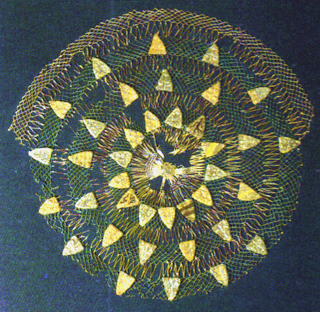Before this gets buried too deep in the stack of posts that have yet to be finished, here is part IV of the Kruseler and Hairdo series. My original plan was to illustrate the description with photos, but I'm not very good at taking pictures of my own back of head, and I won't get around to have some taken soon enough.
Should you try to follow these instructions and keep getting utterly lost, you can tell me in the comment section, and I will try to provide some crude illustration.
The updo I used as the kruseler foundation is commonly called a "log roll", or at least I only know it under this name.
To make a log roll, you do the following:
This is one of my staple updos, since it is fast and well-balanced and does not look bad. But for modern living, I do it only as a single bun worn on the back of the head, not with parted hair and put up on the temples. It is also possible to logroll a braid, something I also do pretty often, but this will not give the sleek look of the "hair horns" that can be seen on the Arnolfini wedding picture, and that was my model for this try.
My main problem is getting the two humps symmetrical and then fixing them securely. They must be firm enough not only to support themselves, but also the (admittedly light) veil, which I pin to the lumps.
I know I'm not the only person wearing or trying to wear a kruseler - so what are your experiences? Have you had problems with the symmetrical arrangement? How do you fix your fabric to the head? How long does it keep in shape?
And most importantly: If you had one single question to ask a medieval kruseler-wearing lady, what would you ask her?
Should you try to follow these instructions and keep getting utterly lost, you can tell me in the comment section, and I will try to provide some crude illustration.
The updo I used as the kruseler foundation is commonly called a "log roll", or at least I only know it under this name.
To make a log roll, you do the following:
- Grow hair. You will probably need mid-back hair or bottom-length hair at least. Fine hairs can usually do it with hair on the shorter end, thick-haired ladies (or guys, of course) need more length.
- Gather hair together in a low ponytail, and hold the ponytail with one hand.
- With the free hand, grasp the hanging end of the tail and wrap it upwards and towards your head over the hand holding the tail. Your first hand should now have hair looped around it.
- Open the hand in the loop slightly, keeping the base of the loop together with the other hand. Now you twist the hand in the loop - this will form a sort of twine underneath the loop. While twisting, pull the hand gently and slowly away from your head, to elongate the twist below the loop.
- Stop pulling and twisting when the twisted section is as long as the back of your head or only slightly longer. You should now have the twisted section, coming from the base of your starting ponytail, and a free-hanging tail of hair coming out of the twist.
- With one hand, hold the twisted section up by the loop so there is some space between the twist and your head. With the free hand, wrap the tail of hair still free around the twist, covering it gradually from bottom to top. That is why you need the length.
- Tuck ends underneath to hide them. Settle finished log roll on your head, going straight up the middle, and secure with your method of choice. Until the roll is firmly secured on your head, always keep hold of the loop, or the roll will uncoil, and you have to start over.
This is one of my staple updos, since it is fast and well-balanced and does not look bad. But for modern living, I do it only as a single bun worn on the back of the head, not with parted hair and put up on the temples. It is also possible to logroll a braid, something I also do pretty often, but this will not give the sleek look of the "hair horns" that can be seen on the Arnolfini wedding picture, and that was my model for this try.
My main problem is getting the two humps symmetrical and then fixing them securely. They must be firm enough not only to support themselves, but also the (admittedly light) veil, which I pin to the lumps.
I know I'm not the only person wearing or trying to wear a kruseler - so what are your experiences? Have you had problems with the symmetrical arrangement? How do you fix your fabric to the head? How long does it keep in shape?
And most importantly: If you had one single question to ask a medieval kruseler-wearing lady, what would you ask her?






